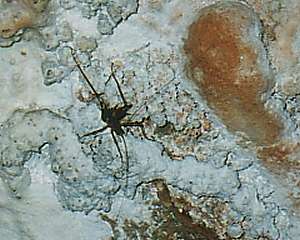Ecosystems at Risk: Limestone caves
5c. Adjustments in response to natural stress
Organisms have evolved very specialised adaptations, often quite bizarre,
to the very stable unchanging cave environment of:
- very small or no seasonal or diurnal climatic changes
- no light
- low temperatures
- high humidity
- no plants to provide food via the traditional food chain of plant, herbivore and carnivore
- high carbon dioxide levels
Cave animals are classified as either troglobites, troglophiles or trogloxenes depending on the amount of time they spend in the dark zone of caves. Troglobites spend their whole life in caves. Troglophiles are found living permanently in caves but can also live successfully in suitable surface habitats. Trogloxenes return to the surface for food and include animals such as bats.
 General
adaptations include:
General
adaptations include:
- a loss of pigmentation
- partial or total loss of eyes
- extension of sensory hairs or antennae
- elongated legs
- reduced size
- chsnges to reproductive behaviour such as fewer but larger eggs.
The cave cricket at right has many but not all of these adaptations. Is it likely to be a troglobite, troglophile or trogloxene?
Other Adjustments
With the absence of plants, most organisms are either detritivores (scavengers)
or carnivores. The lack of food energy means animals are never numerous
and the total animal biomass of caves is very small when compared to other
ecosystems.
| change |